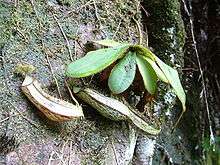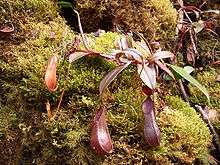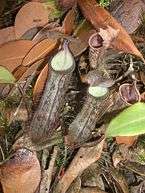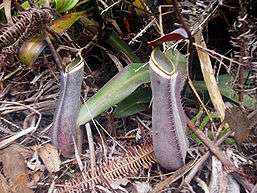Nepenthes adnata
| Nepenthes adnata | |
|---|---|
 | |
| Lower pitcher of Nepenthes adnata | |
| Scientific classification | |
| Kingdom: | Plantae |
| (unranked): | Angiosperms |
| (unranked): | Eudicots |
| (unranked): | Core eudicots |
| Order: | Caryophyllales |
| Family: | Nepenthaceae |
| Genus: | Nepenthes |
| Species: | N. adnata |
| Binomial name | |
| Nepenthes adnata Tamin & M.Hotta ex Schlauer (1994)[1] | |
Nepenthes adnata /nᵻˈpɛnθiːz ædˈnɑːtə/ is a tropical pitcher plant endemic to the Indonesian province of West Sumatra, where it grows at elevations of 600 to 1200 m above sea level. The specific epithet adnata is Latin for "broadly attached" and refers to the base of the lamina.
Botanical history
Nepenthes adnata was first collected by Willem Meijer on August 24, 1957.[note a] The holotype, Meijer 6941, was collected on that date near the river Tjampo, east of Payakumbuh, Taram, West Sumatra, at an elevation of 1000 m. It is deposited at the National Herbarium of the Netherlands in Leiden.[2]
The species was first described in 1986 by Mitsuru Hotta and Rusjdi Tamin based on specimens the authors collected near Harau in West Sumatra.[3] However, the description was invalid as it lacked a Latin diagnosis.[4] This was provided eight years later by Jan Schlauer.[1]
Description
Nepenthes adnata is a diminutive species. The stem is cylindrical in cross section and may be climbing or drooping. It rarely exceeds 2 m in length and 3 mm in diameter. Internodes are up to 10 cm long.[2]
Leaves are coriaceous and sessile. The lamina is lanceolate-ellipsoidal and may be up to 10 cm long and 2 cm wide. It has an adnate base and an obtuse to acute apex. Two to three longitudinal veins are present on either side of the midrib. Pinnate veins are not easily distinguished. Tendrils may be up to 5 cm long.[2]

Rosette and lower pitchers are ovoid in the lower third and cylindrical above. They are small, reaching only 10 cm in height and 2.5 cm in width. A pair of fringed wings (≤3 mm wide) runs down the front of terrestrial pitchers. The glandular region covers only the lower third of the inner pitcher surface. The pitcher mouth is round and slightly oblique throughout. The cylindrical peristome is up to 2 mm wide and bears indistinct teeth.[2] The peristome is roughly symmetrical in cross section, with the inner portion accounting for around 54% of its total cross-sectional surface length.[5] The lid or operculum is orbicular and cordate at the base. Multicellular hairs are sometimes present on its upper surface. An unbranched spur (≤2 mm long) is inserted at the base of the lid.[2]

Upper pitchers are ovoid in the lower quarter and cylindrical to infundibular above. In aerial pitchers, the wings are usually reduced to ribs, but sometimes bear fringe elements. In most other respects, they are similar to lower pitchers.[2]
Nepenthes adnata has a racemose inflorescence. The peduncle is up to 8 cm long. In male plants, the rachis reaches 10 cm in length, while in female plants it rarely exceeds 7 cm. Pedicels lack bracteoles and are up to 10 mm long. Sepals are lanceolate-ovate and around 4 mm long. Fruits are up to 40 mm long.[2]
Short brown hairs are present on the edges of the lamina. The stem and lamina bear a sparse indumentum of simple white hairs (≤2 mm long). Inflorescences are covered with short, red-brown hairs.[2]
The pitchers of N. adnata are generally speckled with reddish-purple blotches. The peristome is usually dark purple. The inner pitcher surface is white to light green. The stem and lamina are green throughout.
Nepenthes adnata varies little across its range. Consequently, no infraspecific taxa have been described.[2]
Ecology

Nepenthes adnata is endemic to the mountains of the Tjampo river region of West Sumatra. Most ridges in this area have an elevation of just below 1000 m, although several exceed this height.[6] The species has an altitudinal distribution of 600 to 1200 m above sea level.[7][8] It grows on mossy sandstone cliff faces amongst dense vegetation. The habitat is moist and receives diffused sunlight.[2][9]
In its natural habitat, the species occurs sympatrically with N. tenuis and grows in close proximity to N. albomarginata, N. ampullaria, N. eustachya, N. gracilis, N. longifolia, and N. reinwardtiana. Despite this, N. adnata has no known natural hybrids.[2][7] In Kelok Sembilan, the species has been found to grow alongside Utricularia striatula, a distantly related carnivorous plant.[2]
Only two collections of this species have been made and these correspond to two populations separated by several kilometres of mountainous terrain. The species may be more widespread in the region, but most cliffs in the Tjampo river area are virtually inaccessible, making the discovery of new localities unlikely in the near future. The only population that is easily accessible is very small and frequently visited by plant collectors. Charles Clarke considers this population "severely threatened".[2] However, since the full extent of its range is unknown, the conservation status of N. adnata is listed as Data Deficient on the 2006 IUCN Red List of Threatened Species.[10] The habitat of this species may be threatened in the near future by fires deliberately started to clear forest for agricultural purposes.[2]
Related species

Nepenthes adnata has no obvious close relatives within the genus. Rusjdi Tamin and Mitsuru Hotta considered the species to be closely related to N. tentaculata, N. gracillima, and N. gracilis.[3] Both Jan Schlauer and Joachim Nerz[1] as well as Matthew Jebb and Martin Cheek[4] agreed that N. adnata and N. tentaculata are related, while J. H. Adam, C. C. Wilcock and M. D. Swaine considered the two taxa conspecific.[11] However, Charles Clarke does not support this interpretation, stating that the similarities between the two species are probably coincidental and that the closest relatives of N. adnata "are more likely to be other Sumatran species such as N. gymnamphora, N. longifolia or N. albomarginata".[2] Clarke points out that the multicellular hairs sometimes exhibited by N.adnata, which several authors have used to suggest a relationship with N. tentaculata, occur in rosette pitchers of many other species, especially N. rafflesiana.[2]
The pitchers of N. adnata are similar to those of N. tobaica, although the stem and lamina are quite different. They also bear a superficial resemblance to those of a form of N. gymnamphora from Mount Sorik Merapi.[2] Seedlings of N. adnata and N. longifolia are virtually indistinguishable, although mature plants have few morphological features in common. N. adnata also shares with N. albomarginata a similar indumentum and ecology.[2]
In 2001, Clarke performed a cladistic analysis of the Nepenthes species of Sumatra and Peninsular Malaysia using 70 morphological characteristics of each taxon. The following is a portion of the resultant cladogram, showing "Clade 6", which is only weakly supported at 50%. The sister pair of N. angasanensis and N. mikei has 79% support.[2]
 Lower pitchers of N. adnata |
 Lower pitchers of the purple form of N. albomarginata |
| 50% |
| |||||||||||||||||||||||||||||||||||||||
| |
Notes
- a.^ Meijer explored the forest of the Tjampo region between August 20 and August 28.[12] He collected N. adnata on August 24 together with the type material of N. tenuis and the first known specimen of N. longifolia.[13]
References
- 1 2 3 Schlauer, J. & J. Nerz 1994. Notes on Nepenthes (Nepenthaceae). I. Contributions to the Flora of Sumatra. Blumea 39: 139–142.
- 1 2 3 4 5 6 7 8 9 10 11 12 13 14 15 16 17 18 19 Clarke, C.M. 2001. Nepenthes of Sumatra and Peninsular Malaysia. Natural History Publications (Borneo), Kota Kinabalu.
- 1 2 (Indonesian) Tamin, R. & M. Hotta 1986. Nepenthes di Sumatera: The genus Nepenthes of the Sumatra Island. In: M. Hotta (ed.) Diversity and Dynamics of Plant Life in Sumatra: Forest Ecosystem and Speciation in Wet Tropical Environments. Part 1: Reports and Collection of Papers. Kyoto University, Kyoto. pp. 75–109.
- 1 2 Jebb, M.H.P. & M.R. Cheek 1997. A skeletal revision of Nepenthes (Nepenthaceae). Blumea 42(1): 1–106.
- ↑ Bauer, U., C.J. Clemente, T. Renner & W. Federle 2012. Form follows function: morphological diversification and alternative trapping strategies in carnivorous Nepenthes pitcher plants. Journal of Evolutionary Biology 25(1): 90–102. doi:10.1111/j.1420-9101.2011.02406.x
- ↑ Laumonier, Y. 1997. Geobotany 22: The Vegetation and Physiography of Sumatra. Kluwer Academic Publishers, Dordrecht.
- 1 2 McPherson, S.R. 2009. Pitcher Plants of the Old World. 2 volumes. Redfern Natural History Productions, Poole.
- ↑ McPherson, S.R. & A. Robinson 2012. Field Guide to the Pitcher Plants of Sumatra and Java. Redfern Natural History Productions, Poole.
- ↑ Clarke, C.[M.] 1997. Another Nice Trip to Sumatra. Carnivorous Plant Newsletter 26(1): 4–10.
- ↑ Clarke, C.M., R. Cantley, J. Nerz, H. Rischer & A. Witsuba 2000. Nepenthes adnata. 2006 IUCN Red List of Threatened Species. IUCN 2006. Retrieved on 12 May 2006.
- ↑ Adam, J.H., C.C. Wilcock & M.D. Swaine 1992. The ecology and distribution of Bornean Nepenthes. Journal of Tropical Forest Science 5(1): 13–25.
- ↑ van Steenis-Kruseman, M.J., et al. 2006. Cyclopaedia of Malesian Collectors: Prof.dr. Willem ('Wim') Meijer. Nationaal Herbarium Nederland.
- ↑ Nerz, J. & A. Wistuba 1994. Five new taxa of Nepenthes (Nepenthaceae) from North and West Sumatra. Carnivorous Plant Newsletter 23(4): 101–114.
Further reading
- Hernawati & P. Akhriadi 2006. A Field Guide to the Nepenthes of Sumatra. PILI-NGO Movement, Bogor.
- Meimberg, H., A. Wistuba, P. Dittrich & G. Heubl 2001. Molecular phylogeny of Nepenthaceae based on cladistic analysis of plastid trnK intron sequence data. Plant Biology 3(2): 164–175. doi:10.1055/s-2001-12897
- (German) Meimberg, H. 2002. Molekular-systematische Untersuchungen an den Familien Nepenthaceae und Ancistrocladaceae sowie verwandter Taxa aus der Unterklasse Caryophyllidae s. l.. Ph.D. thesis, Ludwig Maximilian University of Munich, Munich.
- Meimberg, H. & G. Heubl 2006. Introduction of a nuclear marker for phylogenetic analysis of Nepenthaceae. Plant Biology 8(6): 831–840. doi:10.1055/s-2006-924676
- Meimberg, H., S. Thalhammer, A. Brachmann & G. Heubl 2006. Comparative analysis of a translocated copy of the trnK intron in carnivorous family Nepenthaceae. Molecular Phylogenetics and Evolution 39(2): 478–490. doi:10.1016/j.ympev.2005.11.023
- (Indonesian) Syamsuardi & R. Tamin 1994. Kajian kekerabatan jenis-jenis Nepenthes di Sumatera Barat. Project report, Andalas University, Padang. Abstract
- (Indonesian) Syamsuardi 1995. Klasifikasi numerik kantong semar (Nepenthes) di Sumatera Barat. [Numerical classification of pitcher plants (Nepenthes) in West Sumatra.] Journal Matematika dan Pengetahuan Alam 4(1): 48–57. Abstract
External links
| Wikimedia Commons has media related to Nepenthes adnata. |
- Photographs of N. adnata at the Carnivorous Plant Photofinder
